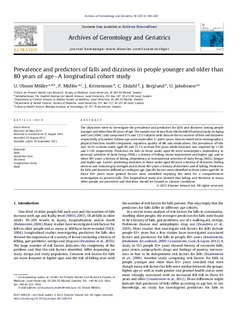| dc.contributor.author | Möller, Ulrika Olsson | |
| dc.contributor.author | Midlöv, Patrik | |
| dc.contributor.author | Kristensson, Jimmie | |
| dc.contributor.author | Ekdahl, Charlotte | |
| dc.contributor.author | Berglund, J. | |
| dc.contributor.author | Jakobsson, Ulf | |
| dc.date.accessioned | 2017-06-07T12:40:05Z | |
| dc.date.available | 2017-06-07T12:40:05Z | |
| dc.date.issued | 2013 | |
| dc.identifier.citation | Olsson Möller, U., Midlöv, P., Kristensson, J., Ekdahl, C., Berglund, J. & Jakobsson, U. (2013) Prevalence and predictors of falls and dizziness in people younger and older than 80 years of age—A longitudinal cohort study. Archives of Gerontology and Geriatrics, 56(1), s. 160-168. | |
| dc.identifier.issn | 0167-4943 | |
| dc.identifier.uri | http://hdl.handle.net/11250/2445132 | |
| dc.description | Artikkelen omhandler en studie hvor hensikten var å kartlegge forekomsten og prediktorer for fall og svimmelhet blant personer yngre og eldre enn 80 år. | |
| dc.description.abstract | The objectives were to investigate the prevalence and predictors for falls and dizziness among people younger and older than 80 years of age. The sample was drawn from the Swedish National study on Aging and Care (SNAC) and comprised 973 and 1273 subjects with data on the occurrence of falls and dizziness respectively at baseline. Follow-ups were made after 3- and 6-years. Data included socio-demographics, physical function, health complaints, cognition, quality of life and medications. The prevalence of falls was 16.5% in those under aged 80 and 31. 7% in those 80+ years while dizziness was reported by 17.8% and 31.0% respectively. Predictors for falls in those under aged 80 were neuroleptics, dependency in personal activities of daily living (PADL), a history of falling, vision impairment and higher age, and in those 80+ years a history of falling, dependency in instrumental activities of daily living (IADL), fatigue and higher age. Factors predicting dizziness in those under aged 80 were a history of dizziness, feeling nervous and reduced grip strength and in those 80+ years a history of dizziness and of falling. Predictors for falls and dizziness differed according to age. Specific factors were identified in those under aged 80. In those 80+ years more general factors were identified implying the need for a comprehensive investigation to prevent falls. This longitudinal study also showed that falling and dizziness in many older people are persistent and therefore should be treated as chronic conditions. | |
| dc.language.iso | eng | |
| dc.subject | Sverige | |
| dc.title | Prevalence and predictors of falls and dizziness in people younger and older than 80 years of age—A longitudinal cohort study | |
| dc.type | Journal article | |
| dc.type | Peer reviewed | |
| dc.rights.holder | Ulrika Olsson Möller | |
| dc.source.volume | 56 | |
| dc.source.journal | Archives of Gerontology and Geriatrics | |
| dc.source.issue | 1 | |
| dc.identifier.doi | 10.1016/j.archger.2012.08.013 | |
